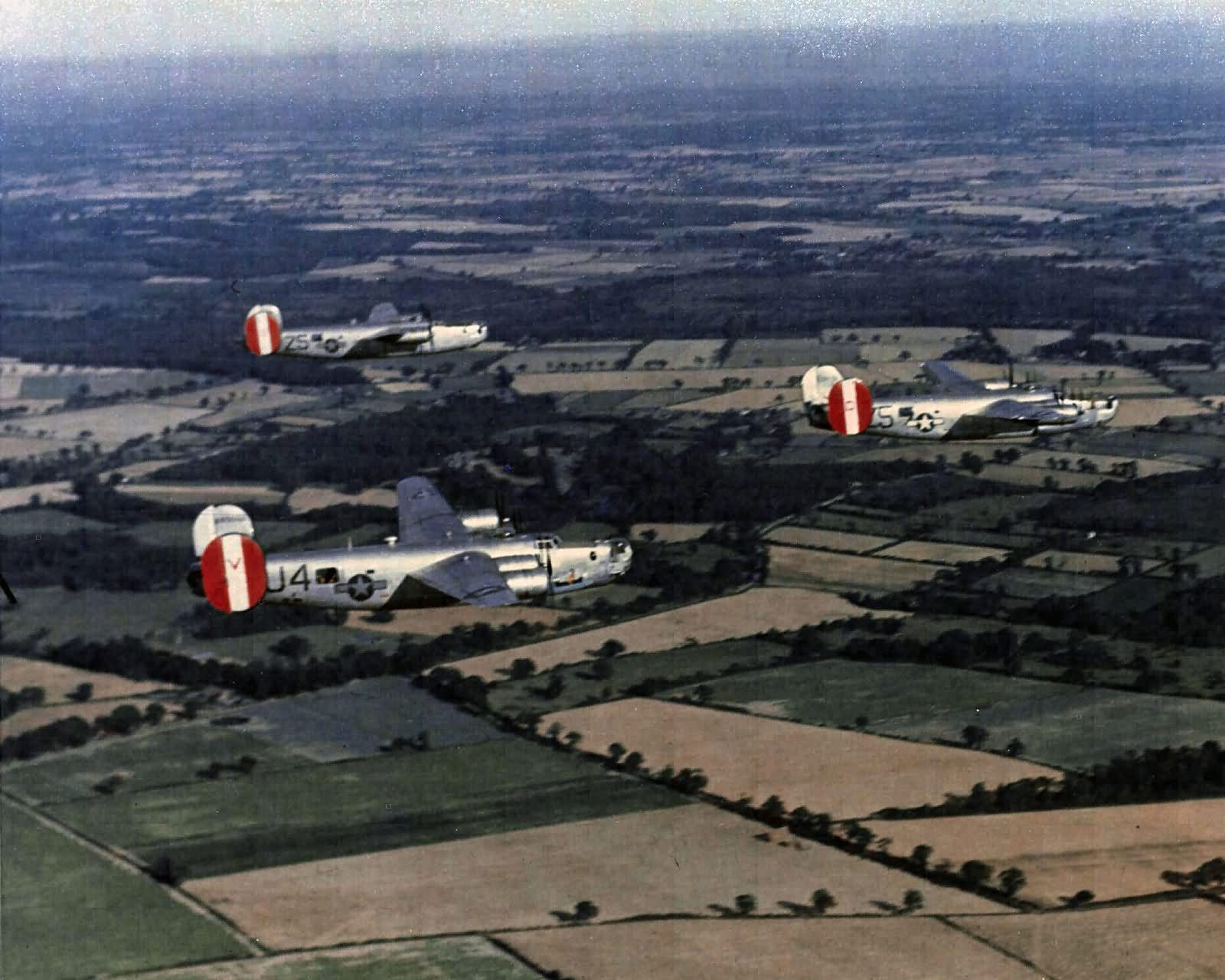The 458th Bomb Group (Heavy):
Overview and Command Assignments
- Assigned to Eighth Air Force: January 1944 – July 1945
- Wing & Command Assignments:
- 2nd Bombardment Division (BD), 96th Combat Bomb Wing (CBW): 11 January 1944
- 2nd Air Division (AD), 96th CBW: 1 January 1945
Component Squadrons
- 752nd Bombardment Squadron (H)
- 753rd Bombardment Squadron (H)
- 754th Bombardment Squadron (H)
- 755th Bombardment Squadron (H)
Combat Aircraft
- B-24H Liberator: From blocks 10-CF and DT, 15-FO
- B-24J, B-24L, and B-24M Liberator
Station
- Horsham St. Faith Airfield, England: c. 29 January 1944 – 3 July 1945
Group Commanding Officers (COs)
- Col James H. Isbell: 16 December 1943 – 9 March 1945
- Col Allen F. Herzberg: 10 March 1945 – 18 June 1945
Mission Details
- First Mission: 24 February 1944
- Last Mission: 25 April 1945
- Total Missions: 240
- Total Credit Sorties: 5,759
- Total Bomb Tonnage: 13,204 tons
- Aircraft Missing in Action (MIA): 47
- Other Operational Losses: 18
- Enemy Aircraft Claims: 28 destroyed, 3 probably destroyed, 14 damaged
Claims to Fame
- The group is noted for conducting the operational test of the Azon radio-controlled bomb for the Eighth Air Force.
History
- Activated: 1 July 1943 at Wendover Field, Utah.
- Training:
- Assembly began at Gowen Field, Idaho, on 28 July 1943 under the command of Lt Col Robert F. Hardy.
- The group trained at Gowen Field until early September 1943, then moved to Kearns Field, Utah, for additional training.
- Headquarters moved to Wendover Field, Utah, on 15 September 1943.
- Final training was conducted at Tonopah Army Air Field, Nevada, beginning on 31 October 1943.
- Deployment to Europe:
- The ground echelon departed for the port of embarkation on 29 December 1943.
- The air echelon flew to the UK via the southern ferry route, with the last aircraft arriving by 18 February 1944.
- The ground echelon sailed from New York on the USS Florence Nightingale on 18 January 1944.
- Redeployment to the USA:
- In June/July 1945, the group returned to the USA.
- Aircraft left Horsham St. Faiths around 14 June 1945.
- The ground echelon sailed on the Queen Mary from Greenock, Scotland, on 6 July 1945, arriving in New York on 11 July 1945.
- After 30 days of rest and recuperation (R&R), the group reassembled at Walker Army Air Field, Kansas, on 25 July 1945, and later at March Field, California, to train as a B-29 unit. However, with the end of the war in the Pacific, the group was inactivated on 17 October 1945.
Aircraft Markings and Color Schemes
B-24 Liberators (January 1944 – July 1945)
Original Paint Scheme: Dark Olive Drab and Neutral Gray factory finish.
- Circle K Group Marking: Applied in early February 1944.
- Vertical Tail: 69-inch diameter white disc with a 36-inch high Insignia Blue letter “K.”
- Wing: The same marking was 78 inches in diameter with a 48-inch letter.
- Tail Number: Repositioned in yellow below the Circle K on the tail.
- Call-Letter: A 24-inch high yellow call-letter was placed below the tail number. All four squadrons used letters from A in alphabetical order, excluding C, which was not used by the 458th Bomb Group.
- Initially, there was no visual means of distinguishing an aircraft’s squadron until mid-March 1944, when SD110 squadron codes were painted on in blue-grey, either 48 inches or 54 inches high, aft of the waist gun positions on both sides of the fuselage.
- 752nd Bomb Squadron: 7V
- 753rd Bomb Squadron: J4
- 754th Bomb Squadron: Z5
- 755th Bomb Squadron: J3
- Circle K Group Marking: Applied in early February 1944.
Natural Metal Finish B-24s (April 1944 onwards):
- Squadron codes and call-letters were painted in black.
- The Group marking was changed to a white letter on a black disc.
High-Visibility Tail Markings (Beginning of May 1944):
- All existing tail markings were removed or painted over.
- New high-visibility colors were applied:
- For the 458th Bomb Group, the fin and rudder were painted overall red on the outward-facing surfaces with a 28-inch or 30-inch vertical stripe in the center.
- A 24-inch high call-letter was painted in red on the center of the white stripe. No bars or plus signs were used.
Pathfinder Aircraft (October 1944):
- All Pathfinder B-24s were concentrated in the 755th Bomb Squadron, which led to some changes in call-letters.
Nose Markings (March 1945):
- The last three digits of the serial number, plus a hyphen and call-letter, were painted on the sides of B-24 noses.
- These markings were 24 inches high, black on bare metal, and yellow on olive drab.
